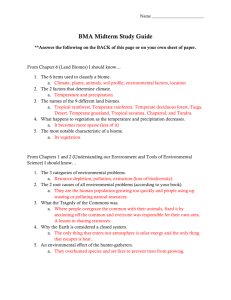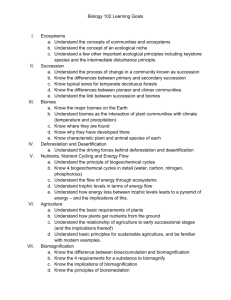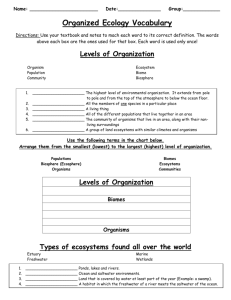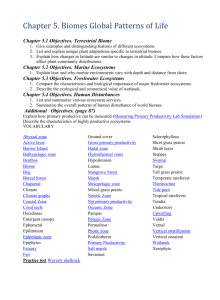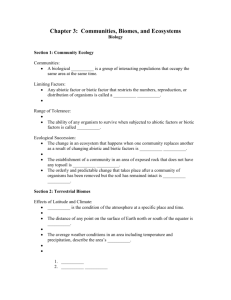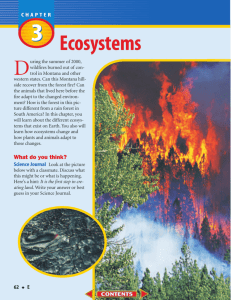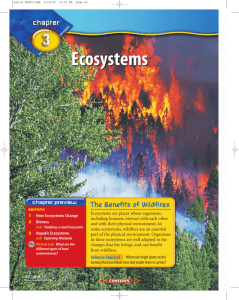Notes: Unit 1 Ecosystems and Biomes
advertisement
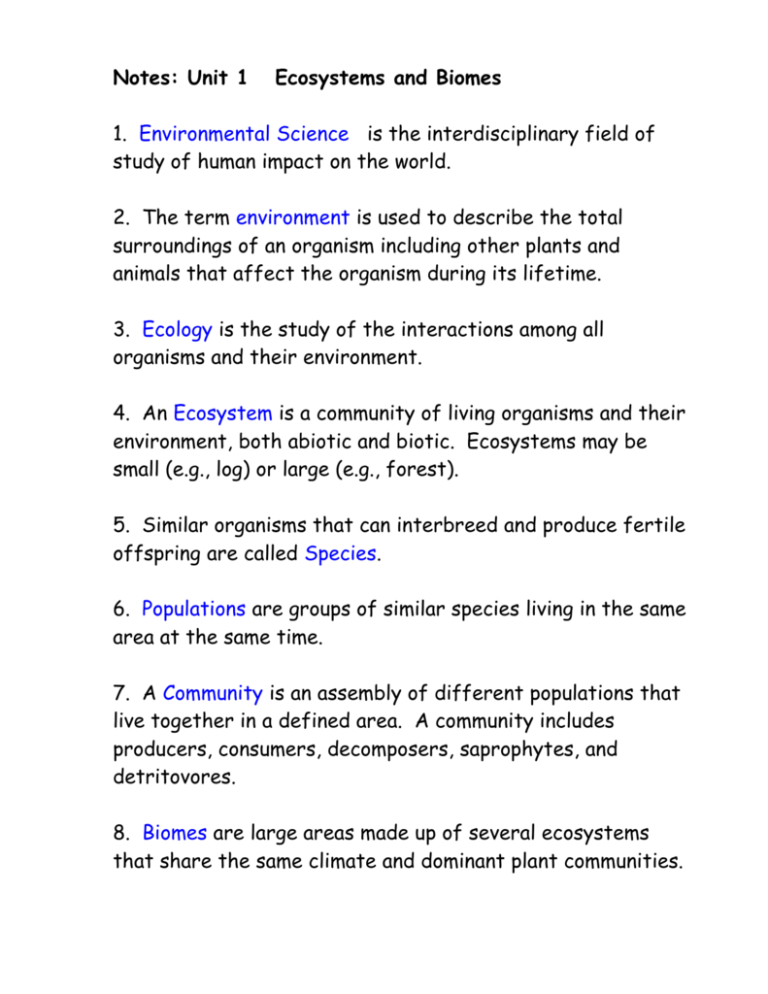
Notes: Unit 1 Ecosystems and Biomes 1. Environmental Science is the interdisciplinary field of study of human impact on the world. 2. The term environment is used to describe the total surroundings of an organism including other plants and animals that affect the organism during its lifetime. 3. Ecology is the study of the interactions among all organisms and their environment. 4. An Ecosystem is a community of living organisms and their environment, both abiotic and biotic. Ecosystems may be small (e.g., log) or large (e.g., forest). 5. Similar organisms that can interbreed and produce fertile offspring are called Species. 6. Populations are groups of similar species living in the same area at the same time. 7. A Community is an assembly of different populations that live together in a defined area. A community includes producers, consumers, decomposers, saprophytes, and detritovores. 8. Biomes are large areas made up of several ecosystems that share the same climate and dominant plant communities. 9. Major Biomes include: 1. Tundra 2. Taiga 3. Temperate Forests 4. Grasslands 5. Chaparral 6. Deserts 7. Rainforests 10. Climate is the prevailing weather conditions in an area over time. Climate plays a major role in determining the distribution of organisms on our biosphere. The major components of climate are temperature, precipitation, light and wind. (Abiotic factors) 11. Temperature is mainly determined by Latitude (degrees North or south of the equator) and Altitude. Temperature is also greatly influenced by proximate to large bodies of water, such as oceans. For every 1000 meter increase in altitude there is a temperature decrease of 10oC. 12. Windward sides of mountains are often wet due to orographic precipitation. Leeward sides are dry (rainshadow). Deserts are often found on leeward sides of mountain ranges. 13. Mountain sides with Southern exposures receive more light in northern latitudes and therefore they often have different vegetative characteristics then mountainsides with northern exposures. The reverse is true in the southern hemisphere. 14. Limiting Factors are any conditions that limit a population’s growth. Factors include the amount of food, water and shelter, the number of predators, and disease. 15. Limiting factors can be Density dependent (competition, predation, parasitism or disease) or density independent (weather, fire, clear cutting, etc) 16. An organism's niche is the conditions under which it can successful survive and reproduce. These conditions include, temperature, amount of water, available nutrients, pH range, etc. Each organism has a range of tolerance within which it can live. (ex. A certain temperature range, the amount of water it can tolerate, the amount of saltwater in can live in, etc.) 17. Ecological Succession is a community change in which new populations of organisms gradually replace existing ones. 18. Primary succession begins in an area where there was no existing community, such as a volcanic island. This rarely occurs. 19. Secondary succession occurs in an area where the existing community is only partially destroyed. (e.g., light fires, wind damage, etc.). Very common. 20. Pioneer species are the first group of organisms to occupy an area undergoing primary succession. Pioneer species tend to be short lived, reproduce rapidly and have minimal requirements (e.g., mice, weeds, insects, etc.) Sometimes referred to as r-selected. 21. Climax communities are stable and well established and have high diversity. Climax species are long lived, and have low reproductive rates (deer, cougar, eagle, oak tree etc). They are sometimes referred to as K-selective. 22. Adaptations in plants and animals occur as living conditions change over long periods of time. The process of developing adaptations is called Natural Selection. 23. Natural selection is driven by selection pressures such as availability of water, sunlight, food, and predator prey relationships. Aquatic Ecosystems/Biomes: 24. Two important aquatic ecosystems are Marine and freshwater. 25. Salt water (35/1000 ppt) covers 75 % of the Earth’s surface. This marine environment is made up of several zones: 1. Intertidal zone (Littoral) – the area along coastlines between high and low tides. Experiences extreme variations in temperature, moisture and salinity. 2. Coastal zone (Neretic) – the region of water over the continental shelf. Highly productive due to the rich supply of nutrients and warmer temperatures. 3. Oceanic zone (Pelagic) – vast open ocean. Unproductive. Benthic communities are sparse due to lack of sunlight. 26. The intertidal zone (Littoral) include three subzones: upper, middle and lower. The upper is only submerged during spring tides and the lower exposed only during spring tides. 27. Estuaries are shallow marine areas where salt water and fresh water mix. The richest estuary in the world is the Chesapeake Bay. 28. Fresh water makes up less than 3 % of the Earth’s biosphere. Yet fresh water is vital to nearly half of the Earth’s organisms. 29. The study of fresh water lakes and ponds is called Liminology. 30. Four important freshwater ecosystems include: rivers, lakes wetlands and vernal pools. 31. Wetlands are among the richest and most valuable terrestrial biomes. They serve as vital nurseries to a variety of wildlife, especially birds. Wetlands also act to filter pollution, reduce siltation, and reduce flooding by acting as a natural sponge to store water. Coastal wetlands protect the mainland from erosion caused by storms and hurricanes. 32. A type of vital terrestrial wetland ecosystem for amphibians and some other organisms are Vernal pools. These pools dry out during the summer and therefore do not contain predator fish that would eat larval amphibians. Most are small and over looked. [Vernal = spring]
